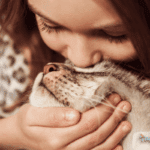Discover why the Kerry Blue Terrier stands out as a hypoallergenic, energetic, and loyal family companion—a perfect match for active households and experienced dog owners alike.
With their striking blue-gray coats and bold personalities, Kerry Blue Terriers bring a perfect balance of elegance and energy. Often praised for their versatility, these spirited dogs excel as both affectionate family pets and agile working dogs. Whether it’s dashing through an agility course or curling up beside their favorite human, the Kerry Blue Terrier embodies loyalty, intelligence, and charm.
Known for their playful yet protective demeanor, Kerry Blue Terriers thrive in environments where they can channel their boundless energy and sharp minds. While their independent streak may require patient training, their affectionate nature and adaptability make them cherished companions for families who appreciate an active, trainable breed.
Kerry Blue Terriers are celebrated for their intelligence and adaptability. Teaching them “Essential Dog Training Commands” can enhance their obedience and showcase their versatility.
Quick Facts: Kerry Blue Terrier
Here’s a snapshot of the Kerry Blue Terrier’s traits to help you understand their unique qualities:
| Characteristic | Description | Rating |
|---|---|---|
| Size | Males: 18–20 in (46–51 cm), 33–40 lbs (15–18 kg); Females slightly smaller | ⭐⭐⭐⭐ |
| Average Lifespan | 12–15 years | ⭐⭐⭐⭐ |
| Intelligence Ranking | Exceptionally intelligent and independent | ⭐⭐⭐⭐⭐ |
| Exercise Requirements | High; need 1–2 hours of activity daily | ⭐⭐⭐⭐⭐ |
| Grooming Needs | High; regular trimming and coat maintenance required | ⭐⭐⭐⭐ |
| Training Adaptability | Very trainable with consistent, positive reinforcement | ⭐⭐⭐⭐ |
| Compatibility with Children | Good with older children; supervision recommended with younger kids | ⭐⭐⭐⭐ |
| Energy Level | High; playful and active | ⭐⭐⭐⭐⭐ |
| Shedding Level | Minimal; hypoallergenic coat | ⭐⭐⭐⭐⭐ |
| Apartment Living | Possible with sufficient exercise and stimulation | ⭐⭐⭐ |
| Health Issues | Prone to hip dysplasia, skin conditions, and eye disorders | ⭐⭐⭐ |
| Cost of Ownership | Moderate to high; includes grooming, food, and veterinary care | ⭐⭐⭐ |
| Vocal Tendency | Moderate; can bark to alert or when bored | ⭐⭐⭐⭐ |
| Social Needs | High; thrives on companionship and regular interaction | ⭐⭐⭐⭐⭐ |
- • Loyal and Affectionate: Kerry Blue Terriers form deep bonds with their families. Their loyal and affectionate nature ensures they’re always eager to be by your side, offering companionship and devotion.
- • Highly Intelligent and Independent: These terriers are renowned for their sharp minds and independent streak. While they excel in advanced training and agility, their cleverness requires consistent boundaries to keep them focused.
- • Energetic and Spirited: With their high energy levels, Kerry Blue Terriers thrive in active households. Daily walks, vigorous play sessions, and mental challenges are essential to keep them physically and mentally stimulated.
- • Hypoallergenic Coat: Their unique, curly blue-gray coat not only adds to their charm but also makes them a great choice for allergy sufferers. However, their coat requires regular grooming to prevent matting and maintain its texture.
- • Protective and Alert: True to their terrier heritage, Kerry Blue Terriers are naturally protective. While this makes them excellent watchdogs, early socialization is crucial to ensure balanced behavior.
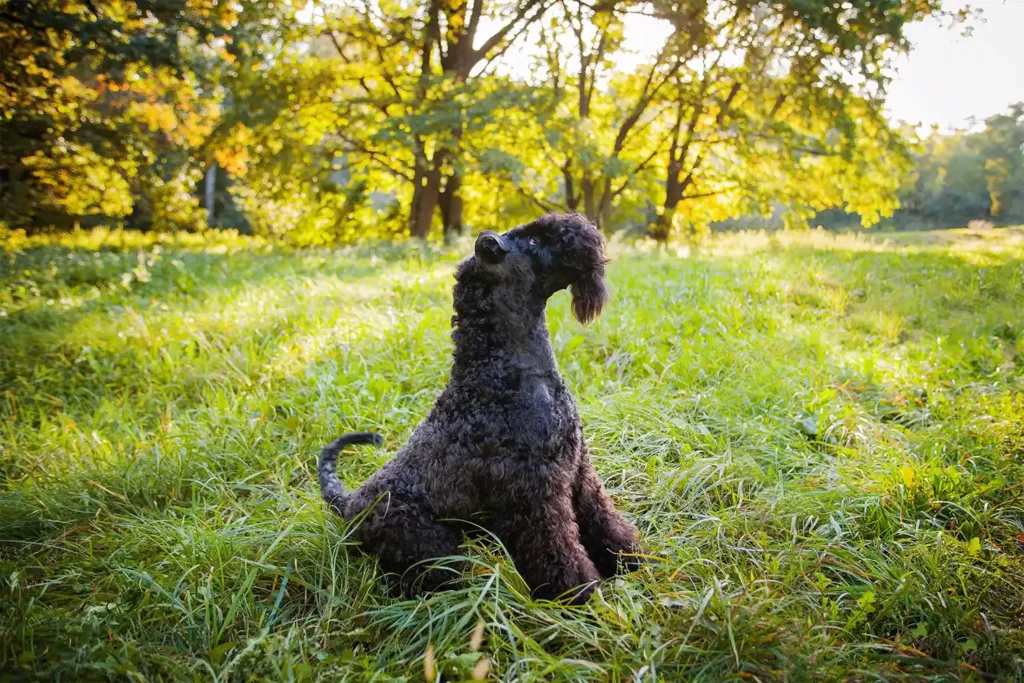
History and Origins of the Kerry Blue Terrier
The Kerry Blue Terrier, often described as a spirited and intelligent breed, boasts a rich history rooted in Ireland’s picturesque County Kerry. Initially bred as all-purpose farm dogs, these versatile canines excelled at herding livestock, hunting vermin, and guarding homes. Over the centuries, their striking blue-gray coats and bold personalities have elevated them to international recognition as both show stars and cherished companions.
Quick Facts About Kerry Blue Terrier Origins
| Aspect | Detail |
|---|---|
| Geographic Origin | County Kerry, Ireland |
| Purpose | Herding livestock, hunting vermin, and guarding property |
| First Recognition | Recognized by the Irish Kennel Club in the 1920s |
| Introduction to the U.S. | Early 20th century; gained popularity as both show dogs and family pets |
| Notable Contributions | Show dogs, hunting companions, and guardians |
| Breed Development | Crossbred from local terrier breeds to enhance intelligence, stamina, and adaptability |
Kerry Blue Terrier Breed Development in Ireland
In the mid-19th century, Lord Dudley Marjoribanks, later known as Lord Tweedmouth, sought to In the 18th century, farmers in County Kerry faced the need for a dog capable of excelling in diverse roles. The Kerry Blue Terrier arose as a solution, bred from local terrier lines to combine intelligence, stamina, and versatility. Their hallmark blue-gray coat—a genetic rarity—became a defining trait that set them apart.
Traits That Shaped the Breed:
- Loyalty and Versatility: Whether herding sheep or guarding homes, their adaptability was unmatched.
- Intelligence and Drive: Farmers relied on their quick thinking and determination for complex tasks.
- Hunting Abilities: Their tenacity made them exceptional at hunting pests, from rats to badgers.
From Working Fields to Global Recognition
The early 20th century marked a turning point for the Kerry Blue Terrier. With their exceptional intelligence and charm, these dogs transitioned from rural farms to the spotlight of dog shows. Recognized by the Irish Kennel Club in the 1920s, they soon made their way to the U.S., captivating dog lovers with their elegant coats and confident demeanor.
A Breed of Many Talents:
- Show Dogs: Their striking looks and poised gait made them favorites in the show ring.
- Hunting Companions: Their stamina and intelligence ensured success in various hunting roles.
- Family Guardians: Loyal and protective, they excelled as trusted family companions.
Why the Kerry Blue Terrier Stands Out
From the lush fields of Ireland to modern family homes, the Kerry Blue Terrier’s journey exemplifies resilience and adaptability. Their ability to excel in diverse roles—whether as farm dogs, show stars, or devoted pets—cements their place as one of the most versatile and beloved terrier breeds.
Before welcoming a Kerry Blue Terrier into your home, consider these “10 Essential factors for bringing a new pet home”.
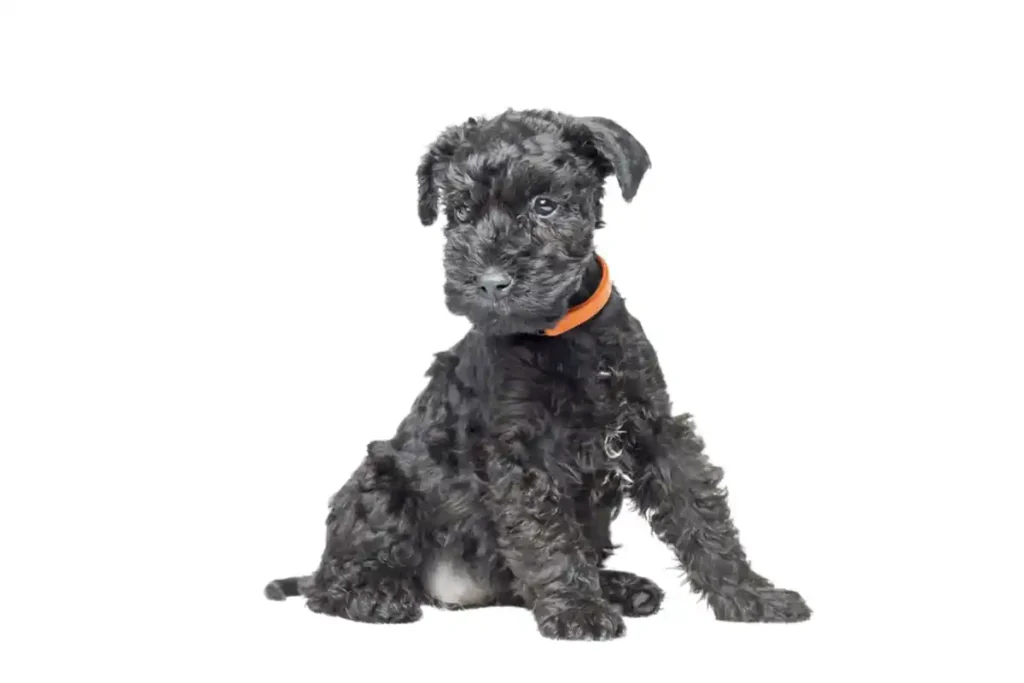
Personality Traits of the Kerry Blue Terrier
The Kerry Blue Terrier, celebrated for its spirited, bold, and intelligent nature, is a breed that thrives in active households. Known for their unwavering loyalty and playful demeanor, these terriers are deeply affectionate with their families while maintaining an independent streak that highlights their terrier heritage. Their adaptable personality ensures they excel as both working dogs and loving companions.
Table: Kerry Blue Terrier Personality Profile
| Trait | Description |
|---|---|
| Intelligence | Highly intelligent and quick learners; excel in problem-solving and training. |
| Energy Level | Very high energy; require 1–2 hours of exercise daily to remain satisfied. |
| Social Interaction | Affectionate with family but can be reserved with strangers; thrives on companionship. |
| Protectiveness | Naturally protective; alert and excellent watchdogs. |
| Trainability | Trainable but can be stubborn; thrives with consistent, positive reinforcement. |
| Compatibility with Kids | Good with older children; supervision recommended with younger kids due to their energy. |
| Compatibility with Pets | May be wary of other dogs; proper socialization is essential for harmony. |
Loyal and Affectionate Companions
Kerry Blue Terriers form deep emotional bonds with their families, thriving in homes where they are included as integral members. Known as fiercely loyal dogs, they seek to be involved in daily activities, whether it’s outdoor adventures, games, or quiet moments at home. Their affectionate nature makes them excellent companions, but they also value their independence, requiring an owner who appreciates their spirited personality.
Real-Life Example: Owners often recount stories of their Kerry Blue’s loyalty, such as staying close to a child during illness or eagerly greeting family members at the door after a long day. Their devotion knows no bounds.
Energetic and Playful
With seemingly boundless energy, Kerry Blue Terriers bring a sense of fun and excitement to any household. They require daily exercise to stay mentally and physically stimulated, including activities like brisk walks, agility training, or interactive games. Without sufficient activity, their intelligence and energy may lead to undesirable behaviors such as digging or excessive barking.
Exceptionally Intelligent and Trainable
Kerry Blue Terriers are among the most intelligent terrier breeds, excelling in advanced training tasks and problem-solving. Their quick wit and eagerness to please make them trainable, but their independent nature can sometimes lead to stubbornness. Patience, consistency, and positive reinforcement are key to unlocking their full potential.
Pro Tip: Keep training sessions short and engaging, using treats, verbal praise, or toys as rewards. This keeps their interest while reinforcing desired behaviors effectively.
Real-Life Example: Many Kerry Blues have excelled in competitive obedience and agility, impressing audiences with their sharp minds and athletic abilities. Their versatility often surprises first-time owners who underestimate their trainability.
Protective and Social
As natural watchdogs, Kerry Blue Terriers are alert and protective, making them excellent guardians for their families. While they are affectionate with their loved ones, they may be reserved with strangers, requiring early socialization to ensure confidence and good manners in various situations. With proper exposure, they can adapt well to new environments and people.
Key Insight: Early and consistent socialization helps your Kerry Blue become a well-rounded companion, especially in multi-pet households or homes with frequent visitors.
Real-Life Example: Many families describe their Kerry Blue as the “guardian” of the home, always watching over their loved ones while maintaining a friendly, playful demeanor.
Emotionally Attuned and Independent
Kerry Blue Terriers are not only playful but also deeply attuned to the emotions of their family members. Their sensitivity makes them excellent companions during stressful times, offering comfort and reassurance. However, their independent streak reminds owners that they are still terriers at heart, requiring respect for their autonomy.
Fun Fact: The Kerry Blue’s expressive eyes and attentive nature often give the impression that they truly understand their human companions, further endearing them to their families.
Real-Life Example: Owners frequently share heartwarming stories of their Kerry Blue’s ability to sense and respond to emotions, such as staying close during moments of sadness or excitement.
Why Choose a Kerry Blue Terrier?
If you’re seeking an intelligent, loyal, and energetic companion, the Kerry Blue Terrier is a fantastic choice. Their adaptable nature makes them perfect for active households that can meet their exercise and mental stimulation needs. With proper care, training, and attention, a Kerry Blue Terrier will reward you with endless joy, companionship, and devotion.
Kerry Blue Terriers are celebrated for their intelligence and adaptability. Teaching them “Essential Dog Training Commands” can enhance their obedience and showcase their versatility.
Kerry Blue Terriers thrive on companionship but can develop separation anxiety. Learn more about managing separation anxiety in dogs.
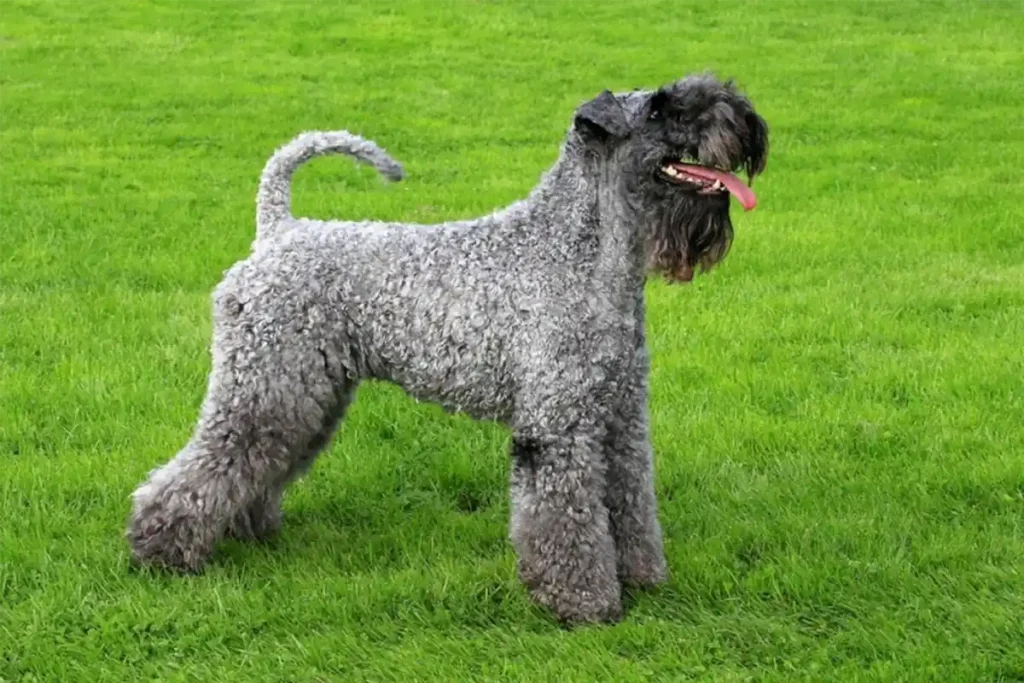
Physical Characteristics of the Kerry Blue Terrier
The Kerry Blue Terrier, with its distinctive blue-gray coat and compact, muscular build, embodies a blend of elegance, strength, and agility. Originally bred for versatility, their physical form reflects their ability to excel in various tasks, from herding livestock to hunting vermin. These striking features make the Kerry Blue Terrier both a visually captivating and functionally capable breed.
Size and Build
| Trait | Description |
|---|---|
| Average Height | Males: 18–20 in (46–51 cm); females slightly smaller |
| Average Weight | Males: 33–40 lbs (15–18 kg); females slightly lighter |
| Body Type | Compact, muscular, and well-proportioned with a strong, athletic build |
Kerry Blue Terriers are medium-sized dogs with a sturdy yet graceful build. Their deep chest, strong back, and well-muscled limbs provide the endurance and agility needed for demanding tasks, such as working on farms or participating in canine sports like agility and obedience.
Notable Features
The Kerry Blue Terrier’s physical features combine functionality with aesthetic appeal, showcasing their terrier heritage and distinctive charm.
- Eyes: Medium-sized, dark, and almond-shaped, reflecting their alert and intelligent nature.
- Ears: V-shaped, carried forward and slightly folded, adding to their expressive appearance.
- Muzzle: Strong and broad, with a well-defined stop, ideal for gripping and carrying small prey.
- Tail: Set high and carried upright, adding to their confident and spirited demeanor.
Their smooth and flowing movement, combined with a proud carriage, makes them stand out in both the field and the show ring.
Coat and Colors
| Trait | Description |
|---|---|
| Coat Type | Dense, soft, and wavy; requires regular grooming to maintain its unique texture |
| Coat Texture | Thick and luxurious, offering protection in various weather conditions |
| Coloring | Solid shades of blue-gray, ranging from light silver to deep slate |
The Kerry Blue Terrier’s coat is one of their most defining traits. Unlike many breeds, they have a single-layer coat that continues to grow, making regular grooming essential. This hypoallergenic coat benefits allergy-sensitive owners and is a significant draw for families looking for low-shedding dogs. As they mature, their coat darkens, creating a visually stunning transition from puppyhood to adulthood.
Regular bathing, as explained in how to bathe a dog, keeps their coat clean and healthy.
Facial Features and Posture
| Feature | Description |
|---|---|
| Eyes | Medium-sized, dark, conveying intelligence and alertness |
| Ears | V-shaped, folded forward, contributing to their inquisitive expression |
| Tail | Set high and carried upright, reflecting their confidence and energetic spirit |
The Kerry Blue Terrier’s alert yet composed posture reflects their intelligent and confident nature. Whether standing tall or bounding energetically, they exhibit the balance and agility that define their terrier roots.
Key Physical Traits of the Kerry Blue Terrier
- Athletic Build: Compact and muscular, Kerry Blues excel in physically demanding activities, such as agility and herding.
- Unique Coat: Their wavy, hypoallergenic blue-gray coat is ideal for allergy-sensitive families and requires consistent grooming.
- Expressive Features: Dark, intelligent eyes and folded ears enhance their alert and engaging personality.
- Graceful Movement: Their smooth, fluid gait reflects their agility and terrier heritage.
Why Understanding These Characteristics Matters
The Kerry Blue Terrier’s physical characteristics are a harmonious blend of strength, agility, and elegance, making them an exceptionally versatile breed. Their compact, muscular build supports their active nature, while their hypoallergenic, blue-gray coat adds to their unique charm. Whether excelling as a working dog or thriving as a devoted family companion, the Kerry Blue Terrier delivers on every level for owners seeking an intelligent, energetic, and distinctive canine partner.
Why the Kerry Blue Terrier Stands Out
The Kerry Blue Terrier’s physical characteristics blend functionality with elegance, making them a versatile and captivating breed. Their athletic build, hypoallergenic coat, and expressive features ensure they shine in both working roles and family settings, delivering on every front for owners seeking a loyal, energetic, and visually striking companion.
Did you know that some Kerry Blue Terrier love sticking out their tongues? Find out other reasons why in this vet-reviewed guide.
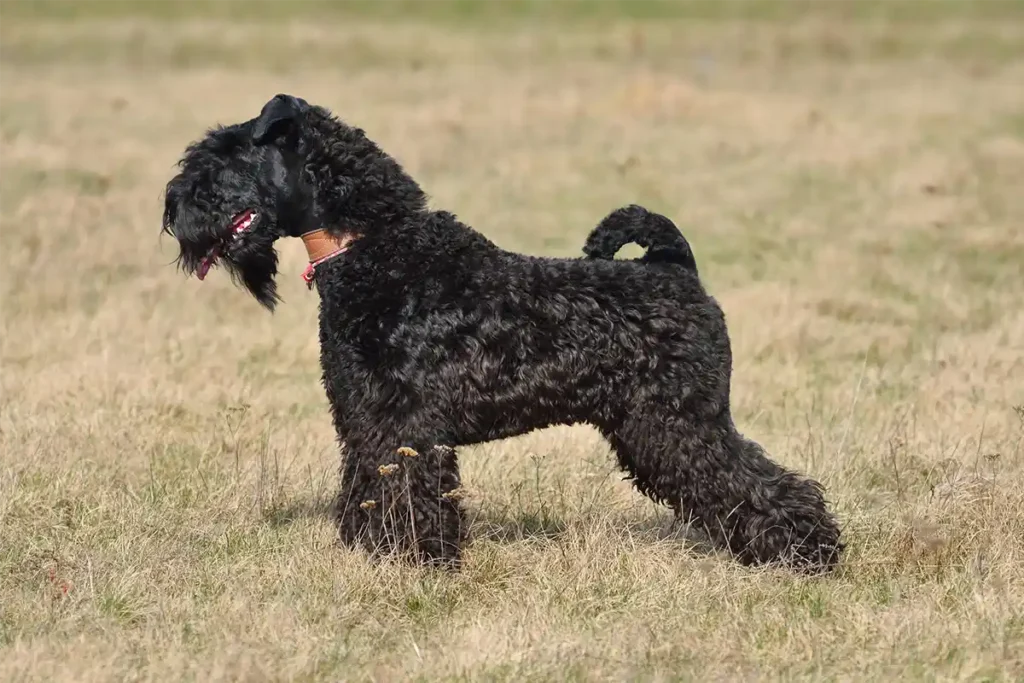
Health and Lifespan of the Kerry Blue Terrier
Kerry Blue Terriers are cherished for their spirited personalities and enduring loyalty, but like all breeds, they are prone to specific health conditions that require attentive care. With an average lifespan of 12 to 15 years, these terriers can enjoy vibrant, healthy lives through proper nutrition, consistent exercise, and regular veterinary checkups. Proactive care ensures they remain energetic and affectionate companions for many joyful years.
Average Lifespan of Kerry Blue Terrier
The typical lifespan of a Kerry Blue Terrier is 12 to 15 years, showcasing their resilience as a medium-sized breed. While they are generally healthy, factors such as genetics, diet, and an active lifestyle greatly influence their longevity. Proactive health measures, including routine screenings and preventive care, play a vital role in maintaining their quality of life.
Common Health Issues in Kerry Blue Terrier
Kerry Blue Terrier are predisposed to several hereditary and lifestyle-related health conditions. Awareness of these concerns allows owners to take proactive steps to manage or prevent them.
| Condition | Description |
|---|---|
| Hip Dysplasia | A genetic condition causing improper hip joint development, leading to discomfort and arthritis. |
| Progressive Retinal Atrophy (PRA) | A hereditary eye condition that causes gradual vision loss, potentially leading to blindness. |
| Dermatitis | Allergies or improper grooming can lead to skin irritation, redness, and itching. |
| Ear Infections | Floppy ears can trap moisture, increasing the risk of bacterial and yeast infections. |
| Hypothyroidism | A hormonal disorder causing symptoms such as lethargy, weight gain, and thinning coats. |
Preventive Care and Regular Vet Checkups
Preventive care is the cornerstone of keeping Kerry Blue Terriers healthy and active. Routine veterinary visits, grooming, and maintaining an ideal weight help mitigate health risks before they escalate.
| Health Aspect | Recommended Action | Frequency |
|---|---|---|
| Hip and Joint Health | Monitor for stiffness or limping; consider joint supplements for support. | Annually or as needed. |
| Weight Management | Provide portion-controlled meals and encourage regular exercise. | Monthly monitoring. |
| Eye Health | Screen for PRA and other vision concerns. | Annually. |
| Coat and Skin Care | Brush regularly to prevent matting and irritation. | Weekly grooming. |
| Ear Hygiene | Clean ears to reduce the risk of infections. | Weekly. |
| Thyroid Screening | Conduct blood tests to detect hypothyroidism early. | Annually. |
Signs of Illness to Watch For in Kerry Blue Terrier
Early detection of health concerns can improve outcomes and ensure a longer, healthier life for your Kerry Blue Terrier. Keep an eye out for the following symptoms:
- Mobility Issues: Stiffness or difficulty rising may signal hip dysplasia.
- Vision Changes: Bumping into objects or hesitation in dim lighting could indicate PRA.
- Excessive Scratching or Redness: Signs of dermatitis or skin allergies.
- Ear Odor or Discharge: Common symptoms of infections in floppy-eared breeds.
- Lethargy or Weight Changes: Could indicate thyroid dysfunction or other metabolic issues.
Some owners explore options like “CBD oil for dogs” to manage joint discomfort.
Kerry Blue Terrier may face certain health challenges. Stay informed about the “11 Warning signs your dog needs a vet visit”.
Ensuring a Healthy Life for Your Kerry Blue Terrier
Kerry Blue Terriers thrive when their energetic and inquisitive nature is matched with attentive care. Regular physical activity, mental enrichment, and a balanced diet are key to their overall well-being.
Key Areas of Care:
- Nutrition: Provide a high-quality diet suited to their age, size, and activity level. Avoid overfeeding to maintain a healthy weight.
- Exercise: Ensure 1–2 hours of daily activity, such as walks, agility, or playtime.
- Grooming: Brush their coat weekly and clean their ears to prevent infections.
- Veterinary Checkups: Schedule regular screenings for joint, skin, and vision health.
Why Health Awareness Matters
The health and happiness of your Kerry Blue Terrier depend on consistent care and vigilance. By focusing on preventive measures, balanced nutrition, and regular exercise, you can ensure your Kerry Blue Terrier remains a joyful and loyal companion for many years to come.
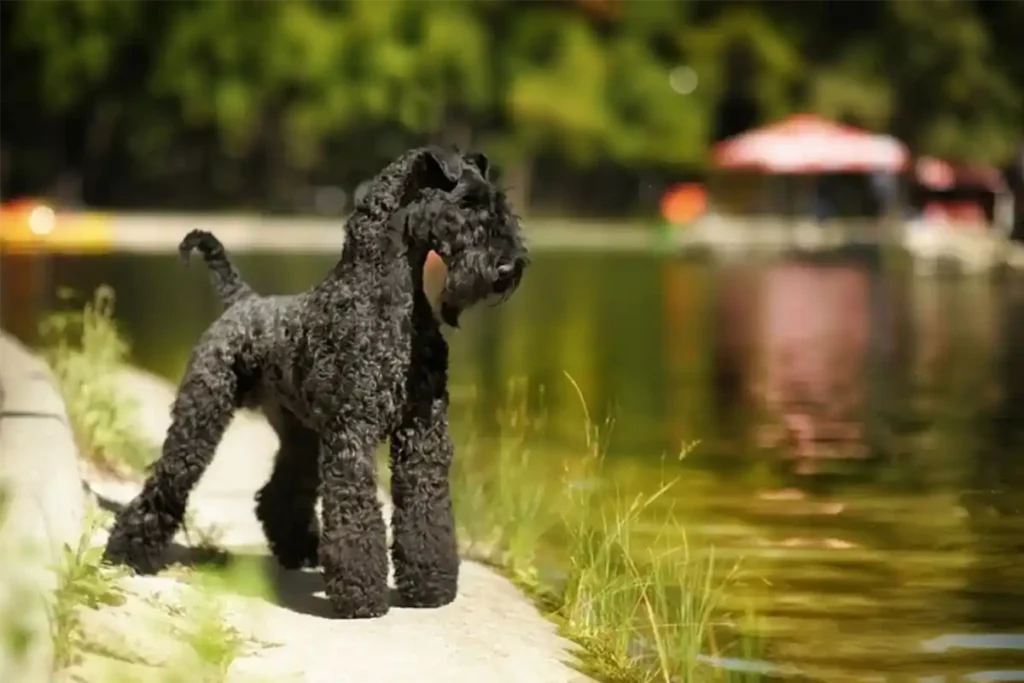
Caring for an Kerry Blue Terrier: Grooming, Diet and Enrichment Tips
Kerry Blue Terriers, celebrated for their spirited energy and affectionate nature, thrive when their physical, mental, and emotional needs are met. By focusing on proper grooming, balanced nutrition, and consistent mental stimulation, owners can ensure their Kerry Blues lead vibrant, fulfilling lives. Understanding and catering to their care requirements is essential for raising a well-rounded companion.
Table: Care Requirements for Kerry Blue Terrier
| Care Aspect | Requirement Level | Frequency | Details | Importance Rating |
|---|---|---|---|---|
| Grooming | Very High | Weekly | Brushing, trimming, and bathing to maintain coat health and texture. | ⭐⭐⭐⭐⭐ |
| Feeding | High | Daily | High-quality protein diet with controlled portions. | ⭐⭐⭐⭐⭐ |
| Exercise | Very High | Daily | 1–2 hours of physical activity like walks, runs, and agility training. | ⭐⭐⭐⭐⭐ |
| Mental Stimulation | Very High | Continuous | Training, puzzle toys, and interactive play to prevent boredom. | ⭐⭐⭐⭐⭐ |
| Environment | High | Continuous | Secure outdoor areas and comfortable resting spaces. | ⭐⭐⭐⭐ |
Grooming: Maintaining That Iconic Blue-Gray Coat
The Kerry Blue Terrier’s dense, wavy coat requires consistent care to maintain its unique texture and prevent matting. Without regular grooming, their coat can lead to discomfort or skin irritation.
Key Grooming Practices:
- Brushing: Use a slicker brush 2–3 times a week to remove tangles, prevent matting, and distribute natural oils.
- Bathing: Bathe monthly with a hypoallergenic, dog-safe shampoo to keep their coat clean and shiny without stripping natural oils. “How to Bathe a Dog: Expert Tips for Stress-Free Grooming”
- Trimming: Schedule professional grooming every 6–8 weeks to maintain their coat’s signature look.
- Ear Care: Clean their ears weekly with a vet-approved solution to prevent infections.
- Nail Trimming: Trim nails every 2–3 weeks to avoid discomfort or gait issues.
- Dental Hygiene: Brush teeth 2–3 times weekly and provide dental chews to promote oral health.
Diet and Nutrition: Fueling Their Energy and Vitality
Kerry Blue Terriers have high energy needs, requiring nutritionally balanced meals to maintain their vitality, coat health, and weight.
Key Nutritional Needs:
- High-Quality Protein: Opt for premium dog food with real meat or fish as the primary ingredient to support lean muscle mass.
- Healthy Fats: Include Omega-3 and Omega-6 fatty acids for healthy skin and a shiny coat.
- Controlled Portions: Avoid overfeeding to prevent obesity, which can strain their joints and overall health.
Feeding Schedule:
- Adults: Feed 2 meals per day with portions tailored to their size, age, and activity level.
- Puppies: Provide 3–4 smaller meals daily to support growth and development.
Read more on “10 Things to Consider Before Bringing a New Pet Home”
Hydration
Always provide fresh water, especially after exercise or during warm weather. Active dogs like Kerry Blue Terrier require consistent hydration to stay healthy.
Exercise: Channeling Their Boundless Energy
Kerry Blue Terriers are highly active and require daily physical activity to stay fit and mentally engaged.
Physical Activity Recommendations:
- Daily Exercise: Provide 1–2 hours of activities such as brisk walks, runs, or agility training.
- Low-Impact Activities: Swimming is excellent for joint health and provides a full-body workout.
- Agility and Sports: Enroll in agility or obedience classes to challenge their athleticism and intelligence.
Mental Stimulation:
Kerry Blues thrive on mental challenges. Incorporate:
- Puzzle Toys: Encourage problem-solving with treat dispensers or interactive toys.
- Training Sessions: Use positive reinforcement to teach tricks or advanced commands.
- Interactive Play: Introduce scent games or hide-and-seek to engage their instincts.
Interactive toys and training sessions are some of the “9 Simple ways to make your dogs happy”.
Creating a Comfortable Environment
Kerry Blue Terriers are happiest when included in family life. Create a home environment that meets their needs for activity, rest, and enrichment.
- Indoors: Provide soft bedding in a quiet area for relaxation. Use crates as safe spaces for downtime.
- Outdoors: Ensure a secure backyard with enrichment options like obstacle courses or designated digging areas.
Temperature Awareness:
- Hot Weather: Provide shade, fresh water, and avoid outdoor activities during peak heat.
- Cold Weather: While their coat offers some protection, ensure a warm resting area during freezing temperatures.
Why Proper Care Matters
Kerry Blue Terriers are loyal, intelligent companions who thrive with structured care. By focusing on their grooming, diet, exercise, and mental well-being, you can ensure your Kerry Blue Terrier leads a healthy and fulfilling life.
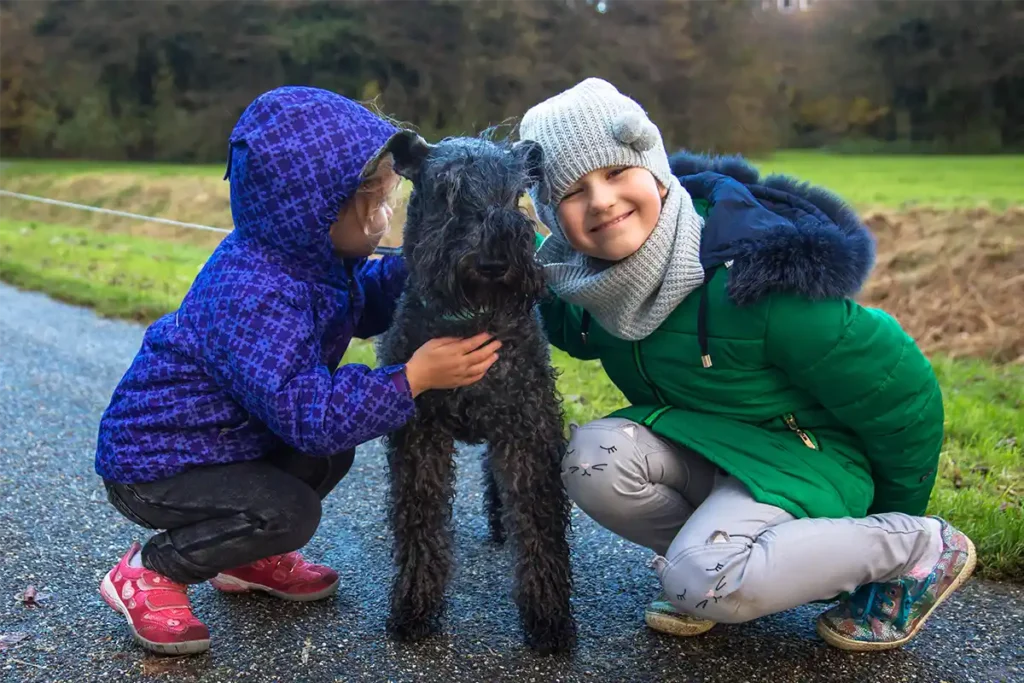
Owning an Kerry Blue Terrier: Budgeting and Financial Insights
Bringing a Kerry Blue Terrier into your home is a joyful and rewarding decision, but it’s essential to understand the financial commitment that comes with owning this unique breed. From initial setup costs to ongoing care expenses, planning ahead ensures your Kerry Blue Terrier receives the care and attention they deserve throughout their life.
Table: Cost Breakdown Analysis for Kerry Blue Terrier
| Expense Category | Initial Cost (USD) | Annual Cost (USD) | Value Rating |
|---|---|---|---|
| Adoption or Breeder Fees | $1,200–$2,500 | N/A | ⭐⭐⭐⭐⭐ |
| Food and Treats | N/A | $600–$1,200 | ⭐⭐⭐⭐⭐ |
| Grooming | $50–$100 | $600–$800 | ⭐⭐⭐⭐ |
| Veterinary Care | $200–$600 | $500–$1,500 | ⭐⭐⭐⭐⭐ |
| Pet Insurance | N/A | $300–$900 | ⭐⭐⭐⭐ |
| Toys and Enrichment | $50–$100 | $100–$300 | ⭐⭐⭐⭐ |
| Training Classes | $100–$500 | Optional | ⭐⭐⭐⭐⭐ |
| Emergency Care | $200–$5,000+ | N/A | ⭐⭐⭐⭐ |
Initial Costs: Preparing for Your Kerry Blue Terrier
Adoption vs. Breeder Fees
- Adoption Fees ($50–$600): Opting for a rescue or shelter is a cost-effective choice, often covering vaccinations, microchipping, and spaying/neutering.
- Breeder Fees ($1,200–$2,500): Purchasing from a responsible breeder ensures health-tested puppies with lineage guarantees, but this comes at a premium.
Essential Supplies for Day One
Prepare your home with the following essentials to ensure a smooth transition for your Kerry Blue Terrier:
| Item | Cost Range (USD) |
|---|---|
| Dog Crate | $50–$150 |
| Food and Water Bowls | $20–$50 |
| Leash and Collar | $30–$60 |
| Bed | $40–$100 |
| Toys | $20–$50 |
| Grooming Supplies | $50–$100 |
| Training Tools | $20–$40 |
Estimated Setup Cost: $200–$500
🐾 Tailwaggors Tip:
Invest in durable supplies like chew-proof leashes, sturdy crates, and long-lasting toys. These may cost more upfront but save money over time.
Ongoing Annual Costs
Food and Treats
Kerry Blue Terriers require a high-quality, protein-rich diet to maintain their energy and overall health. On average, expect to spend:
| Food Type | Annual Cost Range (USD) |
|---|---|
| Dry Food | $400–$800 |
| Wet Food (Optional) | $200–$400 |
| Specialty/High-Protein Diets | $800–$1,200 |
🐾 Tailwaggors Tip:
Mix dry kibble with wet food for added hydration and dental health benefits. Consult your vet to determine appropriate portion sizes based on age, weight, and activity level.
Veterinary Care
Preventive veterinary care ensures your Kerry Blue Terrier remains healthy and avoids costly emergencies:
| Category | Annual Cost Range (USD) |
|---|---|
| Wellness Exams | $150–$300 |
| Vaccinations | $50–$100 |
| Flea, Tick, and Worm Prevention | $100–$200 |
| Dental Cleaning | $300–$600 (every 1–2 years) |
🩺 Veterinary Insight:
“Kerry Blue Terriers are generally healthy but can be prone to certain conditions like hip dysplasia and skin issues. Routine checkups, vaccinations, and dental cleanings are critical to catching health problems early and minimizing expenses later,” advises Dr. Esther Knoetze, BSc, BVSc.
Grooming
Kerry Blue Terriers’ dense, wavy coats require regular upkeep to prevent matting and maintain their distinctive appearance:
| Type | Annual Cost Range (USD) |
|---|---|
| Professional Grooming | $600–$800 |
| At-Home Grooming Supplies | $50–$100 |
🐾 Tailwaggors Tip:
Brush your Kerry Blue Terrier 2–3 times a week using a slicker brush to manage their coat and reduce the frequency of professional grooming visits.
Hidden and Emergency Costs
- Emergency Vet Visits: $200–$5,000+ for surgeries, diagnostics, or critical care.
- Pet Boarding or Sitting: $25–$50 per day during travel.
- Prescription Diets: $500–$1,200 annually for conditions like allergies or obesity management.
🐾 Tailwaggors Tip:
Consider pet insurance to cover unexpected medical expenses, including surgeries and emergency care. Plans typically cost $300–$900 annually but provide peace of mind in emergencies.
Unexpected costs can arise. Prepare with this “Comprehensive Emergency guide for dog owners”.
Cost-Saving Strategies for Kerry Blue Terrier Owners
- Buy in Bulk: Save on food and supplies by purchasing larger quantities during sales.
- Preventive Healthcare: Regular vet visits help catch minor health issues before they become costly problems.
- DIY Grooming: Learn to brush, trim nails, and clean ears at home to minimize professional grooming costs.
- Invest in Quality Supplies: Durable toys, beds, and collars last longer and reduce replacement expenses.
Is Owning a Kerry Blue Terrier Worth the Investment?
Kerry Blue Terriers are loving, loyal companions that bring endless joy to families. While they require financial planning, the investment is well worth the happiness and companionship they provide.
Understanding “10 things to consider before bringing a new pet home” can help prepare for the costs of owning a Kerry Blue Terrier.
🐾 Tailwaggors Tip:
Owning a Kerry Blue Terrier isn’t just an expense—it’s an investment in a spirited, loyal, and intelligent companion. Plan ahead, dedicate the time and resources needed, and your Kerry Blue Terrier will reward you with years of joy, love, and unbreakable friendship.
🩺 Veterinary Insight:
“Kerry Blue Terriers are vibrant and affectionate dogs that thrive with proper care and attention. By budgeting for their grooming, food, and preventive health needs, owners can ensure their Kerry Blue Terriers enjoy long, healthy, and happy lives,” advises Dr. Esther Knoetze, BSc, BVSc.
Disclaimer:
The cost estimates provided in the “Owning an Alaskan Malamute: Budgeting and Financial Insights” section are general approximations based on current market trends and commonly reported expenses in the United States. Actual costs may vary depending on factors such as location, individual pet needs, specific health conditions, and lifestyle choices.
These estimates are intended for informational purposes only and should not replace personal research or consultations with veterinary or pet care professionals. We recommend setting aside additional funds for unexpected expenses, including emergency veterinary care and specialized dietary or training needs, to ensure your Alaskan Malamute receives the best possible care.
Always consult with a veterinarian or trusted breeder for detailed guidance tailored to your specific situation. Tailwaggors is not responsible for discrepancies or unforeseen costs that may arise.
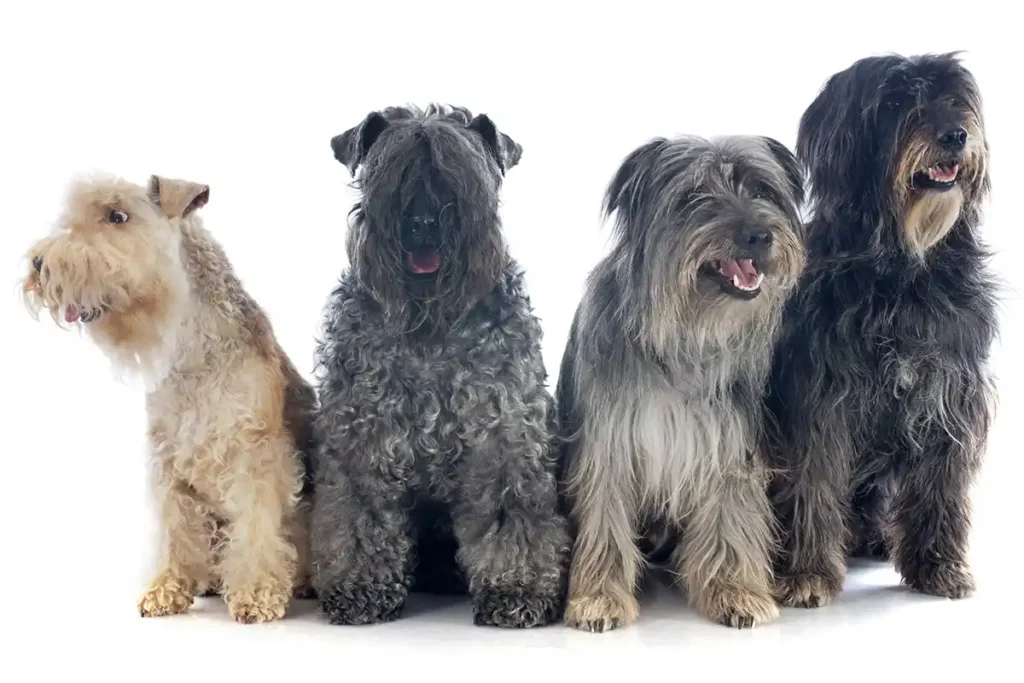
Breed Comparison: Kerry Blue Terrier vs. Other Popular Breeds
Choosing the right breed involves evaluating factors like size, temperament, energy levels, and grooming requirements. The Kerry Blue Terrier, celebrated for its spirited nature and hypoallergenic coat, is often compared to breeds like the Soft Coated Wheaten Terrier, Airedale Terrier, and Standard Schnauzer. Here’s how the Kerry Blue Terrier measures up to help you find the perfect match for your household.
Table: How Does the Kerry Blue Terrier Compare?
| Aspect | Kerry Blue Terrier | Soft Coated Wheaten Terrier | Airedale Terrier | Standard Schnauzer |
|---|---|---|---|---|
| Size | Medium (33–40 lbs / 15–18 kg) | Medium (30–40 lbs / 14–18 kg) | Large (50–70 lbs / 23–32 kg) | Medium (35–50 lbs / 16–23 kg) |
| Coat | Wavy, hypoallergenic, blue-gray | Silky, hypoallergenic, beige/tan | Dense, wiry, tan/black | Dense, wiry, salt/pepper |
| Personality | Spirited, loyal, intelligent | Friendly, adaptable, playful | Bold, independent, energetic | Intelligent, alert, confident |
| Grooming Needs | High (regular trimming) | Moderate (regular brushing) | Moderate (occasional grooming) | High (regular clipping) |
| Energy Level | High; thrives on activity | Moderate; playful and calm | High; very active | High; needs structured exercise |
| Trainability | Trainable but independent | Trainable and eager to please | Trainable but stubborn | Highly trainable, thrives on mental challenges |
| Compatibility with Pets | May be wary without socialization | Friendly with other pets | Good with pets when socialized | Good with other pets |
Kerry Blue Terrier vs. Soft Coated Wheaten Terrier
Kerry Blue Terriers and Soft Coated Wheaten Terriers share hypoallergenic coats and medium sizes but differ in their grooming needs and personalities:
- Coat and Grooming: Kerry Blues require frequent trimming to maintain their luxurious wavy coat, while Wheaten Terriers need regular brushing but less trimming.
- Personality: Kerry Blues are spirited and protective, making them excellent watchdogs, whereas Wheatens are more outgoing and playful, fitting well in multi-pet households.
- Energy Levels: Kerry Blues are more energetic and thrive on mental challenges, while Wheatens have balanced energy levels, making them ideal for moderate exercise routines.
🐾 Tailwaggors Tip: If you’re seeking an intelligent, loyal companion with a bold personality, choose the Kerry Blue Terrier. For a more sociable, easygoing breed, the Soft Coated Wheaten Terrier is a great option.
Kerry Blue Terrier vs. Airedale Terrier
Both Kerry Blue and Airedale Terriers are highly active and intelligent, but they differ significantly in size and coat care:
- Size: Airedales are larger and may require more space and handling, while Kerry Blues are compact and manageable.
- Coat and Grooming: Airedales’ wiry coats are lower maintenance, but Kerry Blues offer hypoallergenic benefits with regular grooming.
- Energy Levels: Airedales tend to be more independent, whereas Kerry Blues bond closely with their families and enjoy interactive play.
🐾 Tailwaggors Tip: For a medium-sized, affectionate companion, the Kerry Blue Terrier shines. If you prefer a larger, bold breed with lower grooming demands, the Airedale Terrier may be a better match.
Kerry Blue Terrier vs. Standard Schnauzer
The Kerry Blue Terrier and Standard Schnauzer are both intelligent, confident breeds, making them ideal for active households:
- Coat and Grooming: Kerry Blues have a hypoallergenic, wavy coat requiring frequent trimming, while Schnauzers’ wiry coats need regular clipping.
- Personality: Kerry Blues are spirited and affectionate, while Schnauzers are more reserved and excel as watchdogs.
- Energy Levels: Both breeds are highly active, but Schnauzers require more structured routines, while Kerry Blues enjoy a mix of activities.
🐾 Tailwaggors Tip: For a loyal, playful companion with a hypoallergenic coat, the Kerry Blue Terrier is an excellent choice. If you want a confident, protective breed, consider the Standard Schnauzer.
Why Choose the Kerry Blue Terrier?
The Kerry Blue Terrier stands out with its bold personality, unique coat, and high energy. Ideal for active families or individuals seeking a loyal and spirited dog, they thrive in environments where they can engage in regular activity and mental stimulation.
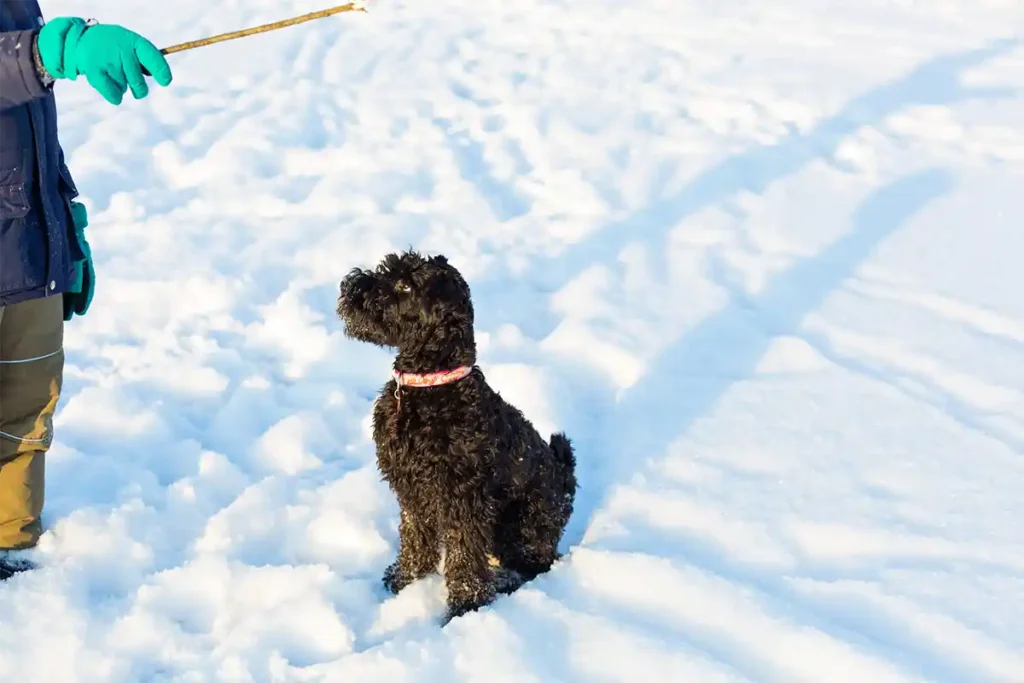
Frequently Asked Questions About the Kerry Blue Terrier
Kerry Blue Terriers are spirited, intelligent, and loyal dogs, admired for their distinctive blue-gray coats and energetic personalities. Whether you’re considering bringing a Kerry Blue Terrier into your home or already share your life with one, these FAQs answer the most common questions about this remarkable breed.
1. Are Kerry Blue Terriers hypoallergenic?
+Yes, Kerry Blue Terriers are hypoallergenic due to their single-layer coat, which produces less dander than most breeds. This makes them a great choice for allergy-prone individuals, though regular grooming is essential to maintain their coat’s condition.
🐾 Tailwaggors Tip:
Brush your Kerry Blue Terrier 2–3 times a week and schedule professional grooming every 6–8 weeks to minimize allergens and keep their coat looking its best.
2. How much do Kerry Blue Terriers weigh?
+Kerry Blue Terriers are medium-sized dogs:
- Males: 33–40 lbs (15–18 kg)
- Females: Slightly smaller
Their compact yet muscular build is well-suited for active lifestyles and diverse roles, from working dogs to family companions.
3. How long do Kerry Blue Terriers live?
+With proper care, Kerry Blue Terriers typically live 12–15 years. Providing a balanced diet, regular exercise, and preventive veterinary care can help them enjoy a long, healthy life.
🩺 Veterinary Insight:
“Routine screenings for hip dysplasia and PRA are vital for maintaining a Kerry Blue Terrier’s health. Supplements like glucosamine can also support joint health in active breeds,” advises Dr. Esther Knoetze, BSc, BVSc.
4. Are Kerry Blue Terriers good with children?
+Yes, Kerry Blue Terriers are affectionate and playful, making them great companions for children. However, due to their energy levels, supervision is recommended during playtime with younger kids to ensure everyone’s safety.
🐾 Tailwaggors Tip:
Introduce structured interactions between your Kerry Blue Terrier and children early to establish positive relationships and boundaries.
5. Do Kerry Blue Terriers bark a lot?
+Kerry Blue Terriers are moderate barkers. They are naturally alert and will bark to warn their families of unusual noises or visitors. Early training can help manage their barking tendencies.
6. How much exercise do Kerry Blue Terriers need?
+These energetic dogs require at least 1–2 hours of daily activity. Ideal exercises include:
- Brisk walks or runs
- Agility courses or obstacle training
- Interactive games like fetch or hide-and-seek
🐾 Tailwaggors Tip:
Combine physical activities with mental challenges, such as puzzle toys or training sessions, to keep your Kerry Blue Terrier engaged and happy.
7. Are Kerry Blue Terriers easy to train?
+Yes, Kerry Blue Terriers are intelligent and eager to learn, though they can exhibit an independent streak. Positive reinforcement and consistency are key to effective training.
🐾 Tailwaggors Tip:
Start training early using reward-based methods. Short, fun sessions with treats and praise will keep them focused and motivated.
8. What are the grooming needs of a Kerry Blue Terrier?
+Kerry Blue Terriers require consistent grooming to maintain their coat’s texture and health:
- Brushing: 2–3 times a week to prevent matting and distribute natural oils
- Bathing: Monthly with a dog-safe shampoo
- Trimming: Every 6–8 weeks by a professional groomer
🩺 Veterinary Insight:
“Grooming not only keeps their coat healthy but also helps identify potential skin issues early. Regular ear cleaning is essential to prevent infections,” advises Dr. Knoetze.
9. Are Kerry Blue Terriers prone to health issues?
+Yes, they can experience certain breed-specific conditions, including:
- Hip Dysplasia: A genetic condition affecting mobility
- PRA: A progressive eye disease leading to vision loss
- Skin Conditions: Allergies and dermatitis are common concerns
Preventive care, including routine vet visits, is key to managing these risks.
10. Can Kerry Blue Terriers live in apartments?
+Yes, Kerry Blue Terriers can adapt to apartment living as long as their exercise and mental stimulation needs are met. Without adequate activity, they may develop destructive behaviors.
🐾 Tailwaggors Tip:
Schedule multiple daily walks, engage in interactive play, and provide enrichment activities to keep your Kerry Blue Terrier happy in smaller spaces.
Why These FAQs Matter
Kerry Blue Terriers are loyal, intelligent, and energetic companions. By understanding their care needs and unique traits, you can ensure they thrive as cherished members of your family.
Are Kerry Blue Terrier safe around plants? Learn which plants to avoid with this vet-approved guide on toxic plants for dogs. Be prepared for emergencies by learning first aid for pets.
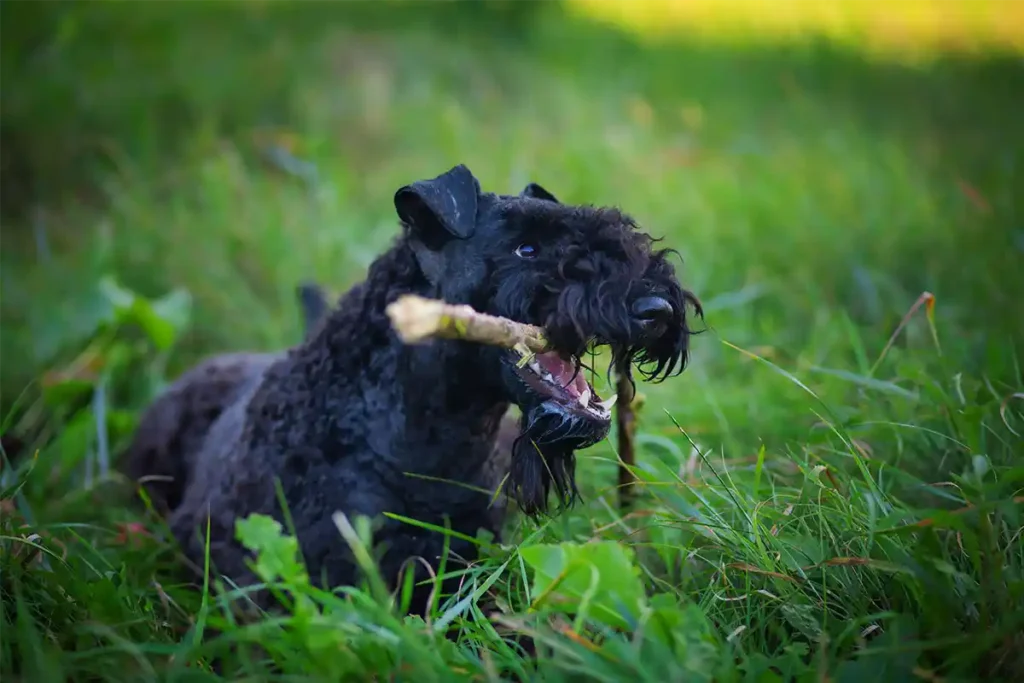
Conclusion: Wrapping Up the Ultimate Guide to the Kerry Blue Terrier
The Kerry Blue Terrier is an extraordinary breed, blending intelligence, loyalty, and charm into a spirited and versatile companion. Whether you’re looking for a lively family pet, a skilled working partner, or a devoted friend, this breed excels in any role it takes on.
Known for their affectionate nature, unique appearance, and playful energy, Kerry Blue Terriers have earned a special place in the hearts of dog lovers worldwide. For active families and individuals who can dedicate time to their grooming and exercise needs, the Kerry Blue Terrier is an exceptional choice.
Explore “7 Proven strategies to strengthen your connection with your pet” for a lifelong bond.
Providing the Best Care for Your Kerry Blue Terrier
Help your Kerry Blue Terrier thrive with these essential care tips:
- Grooming: Maintain their soft, wavy coat with brushing every 2–3 days and professional grooming every 4–6 weeks. Watch for common terrier skin sensitivities.
- Nutrition: Feed a high-quality diet enriched with omega-3 fatty acids to support their coat and overall health.
- Exercise and Mental Stimulation: Provide 1–2 hours of daily exercise, including walks, playtime, and agility training. Engage their sharp minds with interactive toys and games.
- Veterinary Care: Ensure regular checkups to monitor for breed-specific concerns like hip dysplasia, eye disorders, and skin conditions.
Is the Kerry Blue Terrier Right for You?
Bringing a Kerry Blue Terrier into your life is a commitment to a rewarding, lively partnership. This breed is best suited for:
- Active families or individuals who enjoy outdoor activities like hiking or agility sports.
- Owners willing to invest in grooming and training routines.
- Those seeking a loyal, intelligent, and playful companion who thrives on attention.
If you’re ready to welcome a Kerry Blue Terrier into your life, you’ll gain not just a pet, but a devoted member of the family who offers years of companionship, joy, and unconditional love. Read more on 10 things to concider before bringing a new pet home.

Share Your Kerry Blue Terrier Story!
We’d love to hear about your experiences with this spirited breed! Share your favorite moments, care tips, and insights in the comments below. Don’t forget to follow us on social media for expert advice, heartwarming stories, and updates on Kerry Blue Terriers and other incredible breeds. Contact Tailwaggors.
🐾✨ Discover the world of the Kerry Blue Terrier and learn how to provide the best care for this unique breed!
❤️ Share this guide with fellow dog enthusiasts and celebrate the charm of the Kerry Blue Terrier! 🐶❤️






